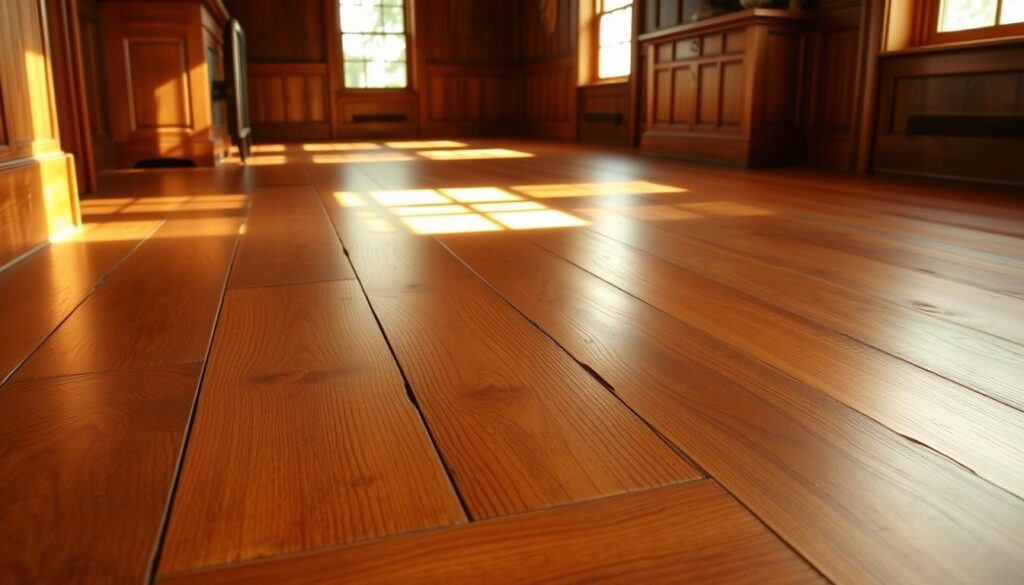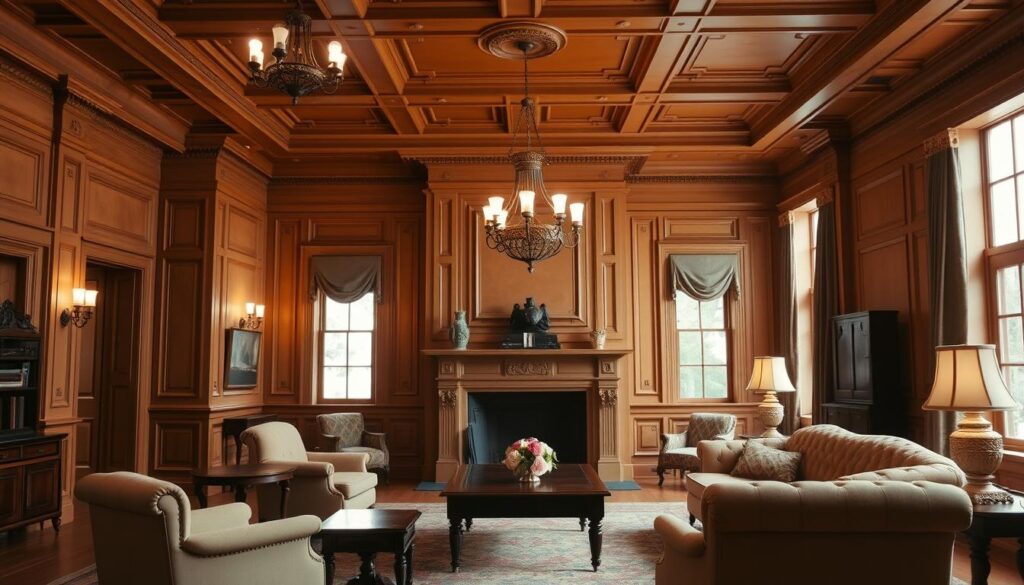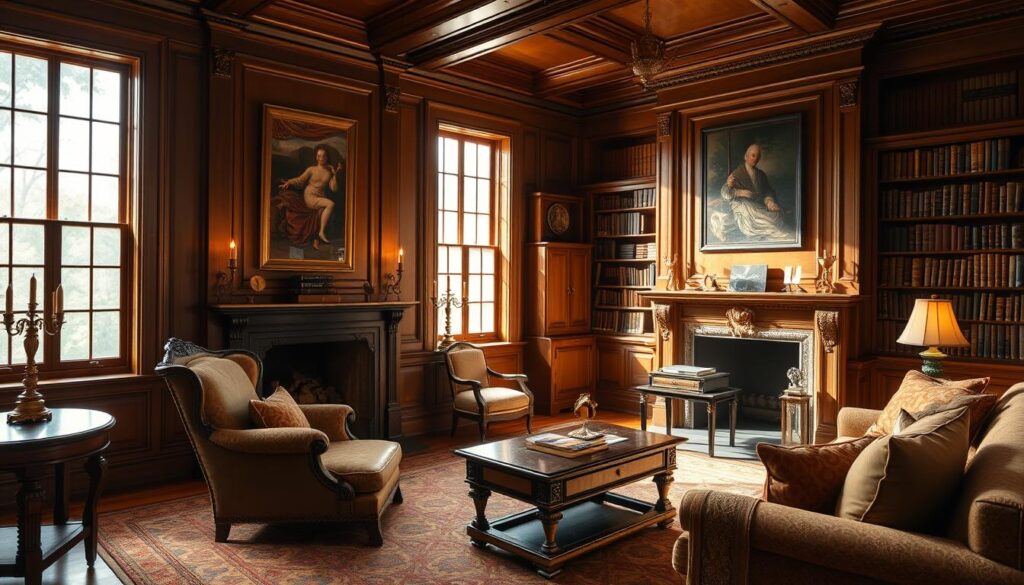Did you know that colonial style decor has been loved for centuries? It still shapes today’s interior aesthetics a lot. Traditional colonial homes are known for their classic beauty and the cozy feel they add to any room.
We’ll show you how to mix old charm with today’s comforts in your home. You’ll learn about using real materials, picking the right furniture, and adding decorative touches. This way, you can make your colonial-style home both timeless and welcoming.
Key Takeaways
- Understand the historical context of colonial decor
- Learn how to choose authentic materials for your interior
- Discover the art of balancing traditional and modern elements
- Explore the role of furniture and decorative accents in colonial-style interiors
- Create a warm and inviting atmosphere with classic elegance
Understanding Colonial Home Interior Design
Colonial home design mixes European and American elements. It shows the early settlers’ diverse backgrounds. This style is more than looks; it’s a window into the past and culture of early America.
To really get colonial style, we must look at its key features, historical roots, and main traits. The colonial era was a time of cultural mixing. This led to a unique style in architecture and interior design.
What Defines Colonial Style?
Colonial style is known for its simplicity and use of local materials. Interiors focused on function, with wooden furniture and fireplaces being common. These elements were both useful and beautiful.
Traditional materials were a big part of colonial design. Wood was a favorite, used for floors, walls, and furniture. The choice of materials was often based on what was available locally. This made colonial homes unique to their regions.
Historical Influences on Colonial Design
The colonial style was shaped by the cultures of European settlers and their interactions with Native Americans. This cultural mix is seen in colonial homes’ architecture and decor. Homes often combined European styles with practical American needs.
Decorative motifs and furniture styles were influenced by Europe. Yet, the need for practicality and local materials also played a big role in colonial interiors.
Key Characteristics of Colonial Homes
Colonial homes are known for several key features:
| Feature | Description |
|---|---|
| Symmetry | Colonial homes often have symmetrical facades and layouts. |
| Classic Furniture | They feature simple, classic furniture that fits the period. |
| Decorative Elements | They include decorative touches like moldings, cornices, and traditional motifs. |
Knowing these traits helps homeowners and designers create authentic colonial interiors. They can also meet today’s needs and tastes.
The Importance of Authentic Materials
Authentic materials are key to colonial-style interiors, adding warmth and character. Genuine materials were a sign of the era’s resourcefulness and skill.
In colonial homes, materials were often local and chosen for their durability and beauty. This ensured the homes lasted long and had a unique character.
Wood: A Timeless Element
Wood was vital in colonial design, used for furniture, flooring, and paneling. Oak, maple, and pine were favored for their strength and beauty.
The woodwork was highly valued, with detailed carvings adding to the beauty. Today, colonial furniture can give your home an authentic look.
Choosing Appropriate Fabrics
Fabrics were crucial in colonial interiors, used for upholstery, curtains, and bedding. The choice of fabric showed the homeowner’s status, with silk and velvet for the wealthy.
For a classic colonial look, use fabrics with traditional patterns like stripes, florals, and geometrics. These patterns add depth and interest while staying true to history.
| Fabric Type | Common Patterns | Typical Use |
|---|---|---|
| Cotton | Stripes, Florals | Upholstery, Bedding |
| Linen | Geometrics, Solids | Curtains, Upholstery |
| Silk | Damask, Brocade | Draperies, Upholstery |
Incorporating Natural Stone into Design
Natural stone was a key material in colonial design, used for fireplaces, flooring, and walls. It added solidity and beauty to the structures.
You can add natural stone to your home through a stone fireplace or stone-tiled floors. These elements honor the traditional use of stone and add elegance.
By using authentic materials like wood, fabrics, and natural stone, you can create a colonial-style interior. This approach respects the past and brings timeless beauty to your home.
Color Palettes for Colonial Interiors
Choosing the right colors is key to a timeless colonial look in your home. The colors you pick greatly affect the feel of your space. It’s important to find hues that match the traditional colonial style and also suit your taste.
Traditional Color Schemes
Traditional colonial colors were inspired by nature. They included soft greens, beiges, and wood grays. These colors were not only beautiful but also practical, made from natural dyes.
Earth tones were common, blending the inside with the outside. Soft blues and reds were used in formal areas, adding elegance.
Modern Interpretations of Colonial Colors
Modern takes on colonial colors offer a wider range of options. Designers now use deeper, richer colors to add depth. For example, a bold navy blue or a warm terracotta can give a classic look a modern twist.
Modern colonial interiors also mix traditional colors with modern touches. This mix can be achieved by combining classic earth tones with modern furniture or decor.
Tips for Selecting the Right Colors
When picking colors for your colonial home, think about the architecture and surroundings. Also, consider the room’s purpose and how colors will change the mood.
- Begin with a neutral base that fits the traditional colonial style.
- Add accent colors that enhance the look, mixing old and new.
- Think about your home’s lighting, as it changes how colors appear.
By choosing your colors wisely, you can create a timeless colonial design. This design honors tradition while showing your personal style.
Furniture Selection for Colonial-Style Spaces
To make a colonial-style space feel real and welcoming, picking the right furniture is key. The right pieces can take you back in time. They bring the elegance and sophistication of the colonial era to life.
Best Furniture Pieces for Authenticity
For a true colonial-style interior, choose furniture that shows the period’s designs. Queen Anne and Chippendale chairs are must-haves. They’re known for their detailed carvings and elegant lines. These pieces add historical charm and make a statement in any room.
Other essential furniture includes four-poster beds and cabinetry with ornate details. These items bring authenticity to kitchens and dining areas.
Balancing Comfort and Aesthetics
While keeping it authentic is important, comfort is also key. Colonial-style furniture is stunning but must be practical. Look for pieces that offer comfortable seating and practical storage solutions. This way, your space will be both beautiful and functional.
Upholstered furniture with traditional patterns like floral motifs or stripes adds to the colonial look while being cozy. Adding plush throw blankets and pillows makes your space warm and inviting.
Mixing Vintage and Contemporary Styles
Mixing vintage and modern furniture creates a unique colonial-style space. This mix makes your interior visually appealing and dynamic. For example, combining a vintage colonial-era dining table with modern chairs creates a striking contrast.
When blending styles, keep a consistent color palette or material theme. This helps tie together different pieces, making your space harmonious and welcoming.
Decorative Accents and Accessories
The charm of colonial-style homes comes from the details. Decorative accents and accessories add warmth and character. They turn a house into a home that shows elegance and simplicity from the colonial era.
Classic Colonial Decorative Elements
Classic colonial decor is simple, elegant, and functional. It includes intricate moldings, carvings, and ornate details on furniture and buildings. These elements add visual interest and honor the era’s craftsmanship.
Moldings and trim can greatly enhance a room’s colonial charm. They come in various forms, like crown molding and chair rails. These details are key to a cohesive and authentic colonial interior.
“The beauty of colonial decor lies in its ability to blend the old with the new, creating a timeless aesthetic that is both elegant and inviting.”
The Role of Artwork in Colonial Design
Artwork is crucial in colonial design, adding sophistication and personality. Traditional interiors often feature classic portraits, landscapes, and still-life paintings. These pieces reflect the era’s artistic tastes and enhance the home’s ambiance.
When picking artwork for a colonial home, choose pieces that match the era’s aesthetic. Opt for framed prints or original paintings that show scenes or motifs from the colonial period.
Functional Yet Stylish Accessories
Accessories are also key in completing the colonial look. It’s important to find a balance between functionality and style. Each accessory should serve a purpose while adding to the overall look.
| Accessory | Description | Style Tip |
|---|---|---|
| Candlesticks | Add warmth with traditional candlesticks | Pair with mercury glass holders for a vintage touch |
| Vases | Use classic vases to display fresh flowers | Choose vases with a simple, elegant design |
| Textiles | Incorporate traditional textiles like linen or cotton | Use them for table runners, napkins, or tea towels |
By carefully choosing decorative accents and accessories, homeowners can create a colonial-style interior that’s both authentic and welcoming.
Floorings Typical of Colonial Homes
The flooring in colonial homes is more than just a necessity. It’s a key design element that shows off the era’s taste. When you’re designing or updating a colonial-style home, picking the right flooring is key. It keeps the home’s historic charm and beauty.

Reclaimed Wood vs. Modern Alternatives
Reclaimed wood flooring is a top pick for colonial homes. It adds a sense of history and warmth. But, modern options like engineered wood or laminate can also work well. They offer durability and styles that can look like reclaimed wood.
When deciding between reclaimed wood and modern options, think about:
- The level of authenticity you want
- Your budget
- How much upkeep you’re willing to do
Reclaimed wood gives a unique look but needs more care. Engineered wood and other modern materials offer a colonial look. They also come with benefits like being more durable and resistant to moisture.
Tile and Stone Options for Colonial Interiors
In colonial homes, tile and stone were common in kitchens and entryways. Marble, slate, and ceramic tiles can make these areas elegant and sophisticated.
Some top tile and stone choices for colonial interiors are:
- Marble: It’s classic, beautiful, and lasts long
- Slate: It has a rustic, earthy look
- Ceramic tiles: They’re versatile and come in many designs
Area Rugs That Complement Colonial Styles
Area rugs are key in enhancing a colonial home’s style. They add warmth and tie the room’s décor together.
When picking area rugs for a colonial home, think about:
- Traditional patterns like florals or geometrics
- Materials like wool or silk for luxury
- Colors that match the room’s palette
By choosing the right flooring and area rugs, homeowners can create a welcoming space. It honors the colonial style’s heritage.
Lighting Choices That Enhance Colonial Vibes
Lighting is key in colonial home interior design. It greatly affects the space’s look. The right lights bring history and tradition, while being useful.
Types of Lighting Fixtures to Consider
For a colonial-style home, many lighting options exist. Traditional items like candelabras and chandeliers add elegance. Modern choices like pendant lights and sconces offer a new look. For more ideas, check out this article on colonial interior design or this guide to designing a colonial home.
| Lighting Fixture | Description | Colonial Style Relevance |
|---|---|---|
| Candelabras | Traditional lighting fixture using candles | High |
| Chandeliers | Central ceiling fixture, often decorative | High |
| Pendant Lights | Modern fixture hanging from the ceiling | Moderate |
| Sconces | Wall-mounted lighting fixture | Moderate |
The Impact of Natural Light
Natural light is vital in timeless colonial design. Big windows and skylights brighten the space. They cut down on the need for artificial light, making the area feel brighter and more welcoming.
Creating Ambiance with Layered Lighting
Layered lighting uses various light sources for a cozy feel. It includes overhead lights, table lamps, and floor lamps. This mix creates a detailed lighting scheme that boosts your home’s colonial style.
In conclusion, lighting is crucial in colonial home interior design. The right fixtures, natural light, and layered lighting make a space warm and inviting. This reflects the timeless beauty of colonial design.
Architectural Features to Highlight
To make a colonial interior look authentic, focus on the architectural features that define it. These elements add character and keep the home’s historical integrity.
Crown Molding and Trim Details
Crown molding and trim are key in colonial architecture. They bring elegance and sophistication to any room. Choosing the right molding is crucial for the room’s look.
Think about the room’s size when picking crown molding. Big rooms can handle detailed moldings, while small ones need simpler designs. The molding’s wood and finish should match the room’s other wooden elements.

Fireplaces as Focal Points
Fireplaces were central in colonial homes, for heat and as a meeting spot. A well-designed mantel can make the fireplace a stunning centerpiece.
The fireplace surround should match the colonial theme. Brick, stone, or wood are common choices. Decorative carvings or designs can make the fireplace even more appealing.
Windows: Styles and Treatments
Windows in colonial homes are more than just for light; they’re architectural highlights. Styles like double-hung and casement, often with shutters, are common. The way windows are treated can change a room’s feel.
| Window Style | Typical Treatment | Colonial Design Element |
|---|---|---|
| Double-Hung | Shutters, Curtains | Multi-paned glass |
| Casement | Shutters, Blinds | Wrought iron hardware |
By focusing on these architectural features, homeowners can keep their colonial-style interiors charming. They also create a cozy and welcoming space.
Outdoor Spaces and Colonial Design
Colonial design isn’t just about the inside; it’s also about making outdoor spaces inviting. These spaces should reflect the charm of a vintage colonial home. We’ll look at how to make your home’s outdoor areas more appealing.
Designing a Colonial-Inspired Porch
A porch inspired by colonial style is a warm welcome to your home. Use traditional materials like wood and add classic features like columns and railings.
- Choose wooden furniture with a classic look to match the porch’s style.
- Add comfy seating and decor that shows off colonial style decor.
- Think about adding a ceiling fan or outdoor lights to improve the feel.
Incorporating Landscaping that Reflects Character
Landscaping is key to showing off your home’s colonial charm. Pick plants and flowers that were popular back then, like boxwood and hydrangeas.
- Go for a formal garden with symmetrical layouts and tidy hedges.
- Use native plants and flowers to add real colonial charm to your vintage colonial home.
- Find garden ornaments and statues that fit the colonial style.
Transitional Spaces Between Indoor and Outdoor
It’s important to make indoor and outdoor spaces blend smoothly. Use the same flooring and colors to make the transition easy.
- Put in big sliding glass doors or French doors to link rooms with the outdoors.
- Use outdoor rugs and furniture that go with your indoor decor.
- Bring plants and greenery inside to connect with the outdoors.
Common Mistakes to Avoid in Colonial Interior Design
Designing a colonial-style interior can be tricky. It’s easy to make mistakes that ruin the charm of the space. We must focus on the traditional colonial interiors we aim to create.
Maintaining Authenticity
One big mistake is straying too far from the real thing. To avoid this, we should stick to classic elements. This includes traditional woodwork and classic furnishings.
Balancing Decorative Elements
Too many decorative elements can also go wrong. We should balance them with negative space. This creates a harmonious atmosphere.
Prioritizing Functionality
Ignoring how the space will be used is another mistake. We must think about the needs of those who will use it. The design should be both beautiful and functional.
Knowing these common mistakes helps us create a colonial-style interior that’s both authentic and welcoming. Our design should capture the classic charm of traditional colonial interiors. It should also meet our modern needs.


